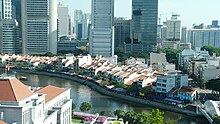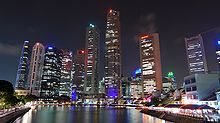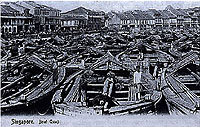Boat Quay
Boat Quay ( Chinese : 驳船 码头, Pinyin : Bóchuán Mǎtóu) is a historic quay in Singapore on the south bank of the Singapore River just above its mouth into the sea.
history
At least since the founding of Singapore in 1819, the Singapore River has been a major hub for trade and the island's economy.
In the 1820s the area was still so swampy that the local traders lived in houses built on rafts. It was fortified with excavation from the construction of Commercial Square, now Raffles Place .
As early as 1822 Sir Stamford Raffles had designated the south bank for a Chinese settlement. Boat Quay was completed in 1842 and was densely populated by Chinese traders and workers. Living conditions were poor, but trade on Boat Quay developed faster than that on the north bank, where Europeans had their offices, homes and government buildings.
Boat Quay also had offices for leading businessmen and philanthropists , called Towkay in South China , such as Tan Tock Seng and Tan Kim Seng . The seemingly confusing trade continued after the new port in Tanjong Pagar was built in 1852 . In particular after the opening of the Suez Canal in 1869, when more and more steamships docked in Singapore, about a third of Singapore's trade was carried out via the Boat Quay.
In the 1960s, the volume of traffic gradually decreased as mechanization and electronic data processing increased in shipping. In September 1983 the Singapore government opened a modern container and transshipment port in Pasir Panjang . This led to a sudden downturn in trade on the river and the area became impoverished after the trading companies had moved in the mid-1980s.
Adaptive reuse of the historical building
The Singaporean government cleared the river in 1983 and had the last remaining barges towed to a new quay at Pasir Panjang. As a result, the buildings on Boat Quay were abandoned and unused from 1983 to 1989.
In 1986 the Urban Redevelopment Authority announced plans to preserve the historic buildings of Boat Quay as part of a master plan to protect the Singapore River and its surroundings.
On July 7, 1989, a zoning plan was published for the South Bridge Road, Circular Road, Lorong Telok and North Canal Road area. The two- and three-story shops with their characteristic 5 foot (1.50 m) wide sidewalks below the upper floors protruding beyond were renovated and converted into new shops.
Subsequently, construction work was carried out on all historical buildings until 1993. The city redevelopment office issued strict guidelines for the restoration. It offered no financial subsidies or tax breaks, but in some cases waived development fees, parking space requirements and car park deficiency charges .
The historic shop buildings could easily be reused as modern restaurants, cafes, bars and small shops. The interior design of the building was adapted for the new use, partly with new, non-traditional interior design with regard to ornaments, materials and colors. For example, the interior of the Opera Cafe in Building No. 40 Boat Quay modified so that it the impression of an opera stage design awakened. The first floor of the Lim family's store at No. 58 Boat Quay has been converted into a Japanese restaurant. The upper floor is still used as a holiday and weekend apartment by the Lim family, who have lived in the building since 1908. The architect Mok Wei Wei created more open space by removing some of the walls, but he has preserved and restored the original teak floor, painted window frames, wooden balcony doors and roof tiles. The antique black wood furniture and art objects have also been restored and reused.
literature
- National Heritage Board: Singapore's 100 Historic Places , Archipelago Press, 2002, ISBN 981-4068-23-3 .
- Victor R. Savage, Brenda SA Yeoh: Toponymics - A Study of Singapore Street Names , Eastern Universities Press, 2003, ISBN 981-210-205-1 .
Web links
- www.boatquay.com.sg (official website)
- www.ura.gov.sg/…/conservation/… (Urban Redevelopment Authority)
Individual evidence
- ↑ Elaine Ee: Singapore's 100 Historic Places. Editions Didier Millet, Singapore, ISBN 978-981-4068-23-9 .
- ↑ a b c d Eunice M. Lin Adaptive Re-use of the Historic Boat Quay Singapore River, Singapore.
- ^ Postcard from the 1960s.
Coordinates: 1 ° 17 '12.6 " N , 103 ° 50' 58.2" E





